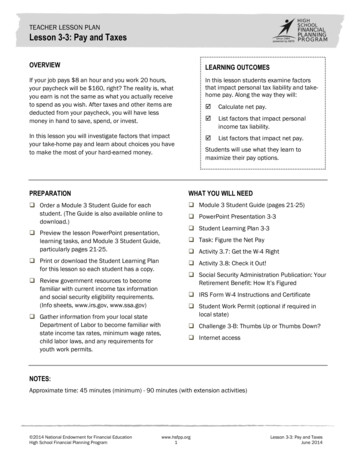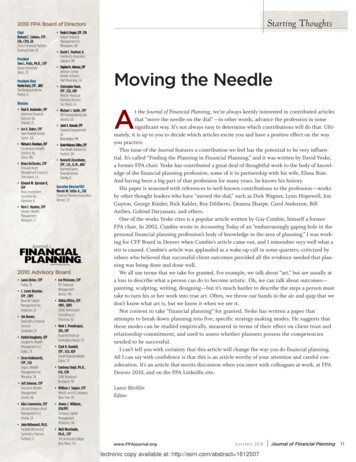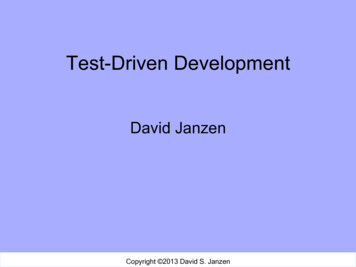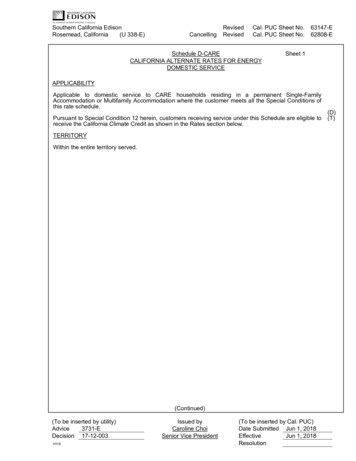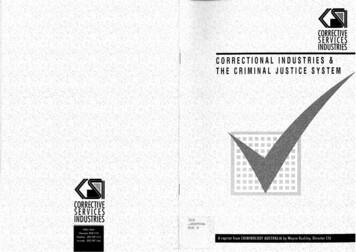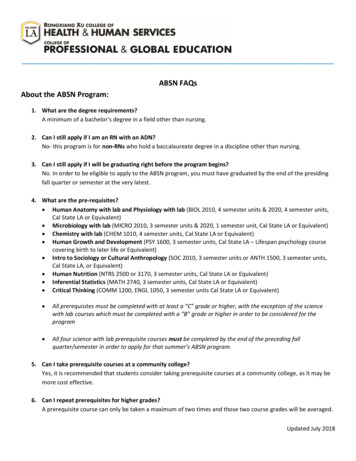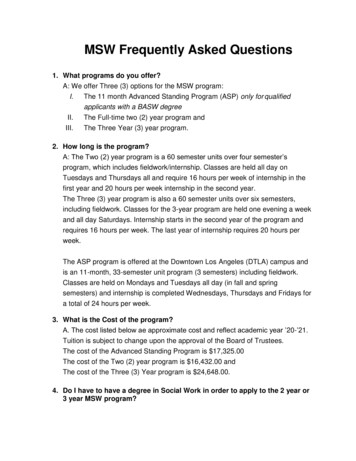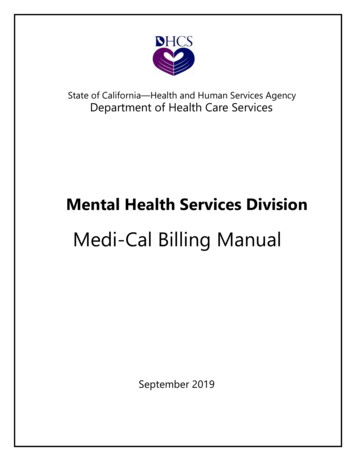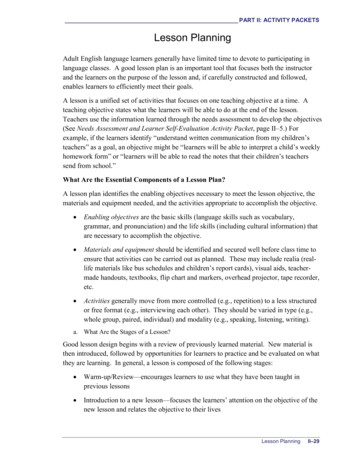
Transcription
PART II: ACTIVITY PACKETSLesson PlanningAdult English language learners generally have limited time to devote to participating inlanguage classes. A good lesson plan is an important tool that focuses both the instructorand the learners on the purpose of the lesson and, if carefully constructed and followed,enables learners to efficiently meet their goals.A lesson is a unified set of activities that focuses on one teaching objective at a time. Ateaching objective states what the learners will be able to do at the end of the lesson.Teachers use the information learned through the needs assessment to develop the objectives(See Needs Assessment and Learner Self-Evaluation Activity Packet, page II–5.) Forexample, if the learners identify “understand written communication from my children’steachers” as a goal, an objective might be “learners will be able to interpret a child’s weeklyhomework form” or “learners will be able to read the notes that their children’s teacherssend from school.”What Are the Essential Components of a Lesson Plan?A lesson plan identifies the enabling objectives necessary to meet the lesson objective, thematerials and equipment needed, and the activities appropriate to accomplish the objective. Enabling objectives are the basic skills (language skills such as vocabulary,grammar, and pronunciation) and the life skills (including cultural information) thatare necessary to accomplish the objective. Materials and equipment should be identified and secured well before class time toensure that activities can be carried out as planned. These may include realia (reallife materials like bus schedules and children’s report cards), visual aids, teachermade handouts, textbooks, flip chart and markers, overhead projector, tape recorder,etc. Activities generally move from more controlled (e.g., repetition) to a less structuredor free format (e.g., interviewing each other). They should be varied in type (e.g.,whole group, paired, individual) and modality (e.g., speaking, listening, writing).a. What Are the Stages of a Lesson?Good lesson design begins with a review of previously learned material. New material isthen introduced, followed by opportunities for learners to practice and be evaluated on whatthey are learning. In general, a lesson is composed of the following stages: Warm-up/Review—encourages learners to use what they have been taught inprevious lessons Introduction to a new lesson—focuses the learners’ attention on the objective of thenew lesson and relates the objective to their livesLesson PlanningII–29
PART II: ACTIVITY PACKETS Presentation—introduces new information, checks learner comprehension of the newmaterial, and models the tasks that the learners will do in the practice stage Practice—provides opportunities to practice and apply the new language orinformation Evaluation—enables the instructor and learners to assess how well they have graspedthe lessonWhat Are Some Practical Considerations in Planning Lessons?A good lesson plan involves consideration of more than just what is going to be taught (theobjective) and how it will be taught (materials, equipment, and activities). The followingelements also need to be thought about and planned for: Sequencing—Do the activities move logically so learners are progressively buildingon what they already know? Do the activities flow well? Are transitions betweenactivities smooth? Pacing—Are activities the right length and varied so that learners remain engagedand enthused? Gauging difficulty—Do the learners have enough skill and knowledge to do theplanned activities? Are the instructions clear? Accounting for individual differences—Do the activities allow for learners ofvarying proficiency levels to receive extra attention they might need, whether belowor above the norm? Are all students actively involved? Monitoring learner versus teacher talk—What is the balance between learner talk andteacher talk? Does the lesson allow a time for learners to interact, producing andinitiating language? Timing—Was the amount of time allotted for each part of the lesson sufficient? Ifthe planned lesson finishes early, is there a backup activity ready? If the lessonwasn’t completed as planned, how can the next class be adjusted to finish thematerial?Most of these aspects of lesson planning are learned by experience, so it is important for theinstructor to evaluate how the lesson went at the end of each class period. Ask the followingquestions: What went well? Why? What did not go as planned? Why?II - 30Lesson Planning
PART II: ACTIVITY PACKETS If I had it to do over again, what would I change? What have I learned about my students that I can account for in future lessonplanning?A lesson plan acts as a road map for a class session. It identifies the destination (objectiveof the lesson) and marks out the route (activities for each stage of the lesson). It is an aid forboth new and seasoned teachers. New teachers should write down the details of eachactivity—perhaps even script them. Experience will guide how detailed a lesson plan needsto be. Sharing the plan with learners (e.g., writing the objective and a brief description ofactivities on the board) keeps both the teacher and the learner focused on where they aregoing, how they are going to get there, and when they arrive.Sample Lesson PlansThe lesson plans that follow are broken down into three categories.1. Lesson Plan Format2. Beginning Level Lesson Plan3. Intermediate Level Lesson PlanReferencesArlington Education and Employment Program. (1994). The REEP adult ESL curriculum (3rd ed.).Available from http://www.apsva.us/reepBrown, H. D. (2001). Teaching by principles: An interactive approach to language pedagogy.Englewood Cliffs, NJ: Longman.McMullin, M. (1992). ESL techniques: Lesson planning. Teacher training through video. WhitePlains, NY: Longman.Schaffer, D., & Van Duzer, C. (1984). Competency-based teacher education workshops inCBE/ESL. Arlington, VA: Arlington County Public Schools.Lesson PlanningII–31
PART II: ACTIVITY PACKETSSample II–14: Lesson Plan FormatClassDateTime:Lesson Objective:Language Skills:Life Skills:Materials:Stages of the LessonWarm nII - 32Lesson PlanningEquipment:
PART II: ACTIVITY PACKETSSample II–15: Lesson Plan: Beginning LevelClass BeginningDateTime: We are assuming the class period is a minimum of two hours. Times listed for the activitiesare approximate. Times for each of the activities will vary depending on number of students in theclass, literacy level of the class, and other factors. A specific lesson plan will always occur in thecontext of prior and subsequent lessons and objectives and other class activities.Lesson Objective: Telephone the school office to report a child’s absence. (In a telephoneconversation role play, students will be evaluated on the following content: giving the name of thechild, the child’s teacher or class, and the reason for the absence.)Language SkillsPossessive pronounsVocabulary: illnesses; sick, absent, appointment; holidaysLife Skills:Cultural information: Schools expect to be informed about a child’s absence.Reasons for absence include sickness, doctor or dentist appointment, religious holiday,family emergency (e.g., death in family)Materials:Equipment: Practice dialogues (handouts, transparency) Overhead projector (OHP) Butcher paper for teacher to draw stick figures Practice telephonesof mother on phone and child with thermometer in mouth Evaluation Checklist Listening gridStages of the Lesson:Warm Up/Review (10 minutes)From previous lessons, review health problems that children frequently have (e.g., stomachache, sorethroat, fever).Introduction“Today we are going to talk about calling the school office when your child is sick and not going toschool.”Presentation (30 minutes)1. Show the students the teacher-created stick drawing of mother and child. Ask the learnerswhat is happening.2. Read dialogue 1 (page II–35) to the students. Ask if they were right about what ishappening.3. Read the dialogue again and ask the following comprehension questions:Who is Mrs. Sanchez calling?Who is sick? What is the matter with her?Why is she calling the school?Who is Mrs. Johnson?Lesson PlanningII–33
PART II: ACTIVITY PACKETS4. Have the class practice the dialogue several times, repeating each sentence after you. Thendivide the class in half and have one half repeat part A and the other half part B. Switchparts.5. Show the dialogue in writing (Transparency of Dialogue 1). Have the students read thedialogue. Ask if there are any words they do not know. If so, discuss the meanings.6. Hand out Dialogue 1 to each student. Have the students work in pairs and practice readingthe dialogue.7. Brainstorm with the whole class other reasons for being absent. Write the reasons on theboard. Discuss which are acceptable and which might not be. Have the students practice thedialogue, substituting the reasons for absence.8. Point out the possessive pronouns “my” and “her.” Discuss their meaning and give severalother examples (e.g., hold up your book and say, “This is my book.” Introduce (or review)my, your, his, her, our, their.9. Hand out Dialogue 2 (page II-33) to each student and put the transparency of Dialogue 2 onthe OHP. Ask the students to circle the possessive pronouns on their copies. Then ask astudent to come up and circle them on the transparency. Have the students check theirpapers. Discuss why the “her” changed to “his.”10. Have the students work in pairs to read the dialogue.Practice (15 minutes)1. As a whole class, brainstorm a list of names of the parents’ children’s schools and teachers.2. In pairs, have the students practice the dialogues, substituting their own information (i.e.,school name, child name, teacher name).Evaluation (30 minutes)1. In pairs, have the students create their own dialogues patterned after Dialogues 1 and 2,selecting information from the brainstormed lists on the board.2. Have each pair come to the front of the room and use the practice telephones to demonstratetheir dialogues. Use the Evaluation Checklist (page II-36) to note inclusion of the followinginformation: name of child, name of child’s teacher, and reason for the absence.3. Have the students in the audience listen for the reason for the absence and write it down onthe listening grid provided (page II-36). (Note: This is preparation for taking a phonemessage; it also keeps the listeners focused.)II - 34Lesson Planning
PART II: ACTIVITY PACKETSTeacher Instructions: See Sample II–15 Lesson Plan: Beginning Level, pages II–31-32, forinstructions on how to use these dialogues.Sample II–16: Student Activity Sheets/TransparenciesDialogue 1Telephoning the School OfficeA. Good morning. Grover Elementary School.B. Hello. This is Mrs. Sanchez.A. How can I help you?B. My daughter won’t be in school today. She has a fever.A. What’s her name?B. Maria Escobar.A. Who is her teacher?B. Mrs. Johnson.A. Thank you for calling. I hope she feels better tomorrow.B. Thank you. Goodbye.A. Bye.Dialogue 2Telephoning the School OfficeA. Good morning. Grover Elementary School.B. Hello. This is Mrs. Sanchez.A. How can I help you?B. My son won’t be in school today. He has a fever.A. What’s his name?B. Jose Escobar.A. Who is his teacher?B. Mrs. Johnson.A. Thank you for calling. I hope he feels better tomorrow.B. Thank you. Goodbye.A. Bye.Lesson PlanningII–35
PART II: ACTIVITY PACKETSSample II–17: Evaluation ChecklistTeacher Instructions: Use this checklist to evaluate students’ practice telephoneconversations as described in the preceding Sample Lesson Plan, pages II–33-34.Student’s NameChild’s NameTeacher/ClassReasonSample II–18: Listening GridInstructions: Have the students listen for the reason for the absences and write it down in thegrid below as described in the preceding Sample Lesson Plan, pages II–33-34.Parent Name1.2.3.4.5.6.7.8.II - 36Lesson PlanningReason For Absence
PART II: ACTIVITY PACKETSSample II–19: Lesson Plan: Intermediate LevelClass Intermediate ESLDateTime: We are assuming the class period is a minimum of two hours. Times listed for the activitiesare approximate. Times for each of the activities will vary depending on number of students in theclass, literacy level of the class, and other factors. A specific lesson plan will always occur in thecontext of prior and subsequent lessons and objectives and other class activities. The following is asample plan using a commercially published textbook. It is included because it contains an activityfor interpreting a weekly homework form, a type of document literacy that most parents will need toread and fill out for their children. Also, we want to show that it is not necessary to create all yourown activities in your lesson plans; textbook exercises can often be adapted or even used as is tomeet your objectives.Lesson Objective: Interpret elementary school weekly homework form.Language Skills:Read a simple chart and explain the following orally: Days of the week School subjects Other vocabulary: daily, weekly, each, comments (new)Life Skills:Cultural information: parents are often expected to monitor or help with children’shomeworkMaterials: Sample homework forms from local schoolsTransparency of one formA Day in the Life of the Gonzalez Family (text, page 49and video scene 6), by C. Van Duzer & M. Burt (1999).Available from the Center for Applied Linguistics, athttp://calstore.cal.org/store/Used with permission.Equipment: Overhead projector VCRStages of the Lesson:Warm Up/Review (10 minutes)Review school subjects by asking learners what their children are studying in school and whichsubjects and skills are listed on their children’s report cards (This is a review of a previous lesson oninterpreting report cards).Review days of the week by asking learners if their children study these every day or only on certaindays.Ask what days the learners study English and wh
17.09.2004 · “Today we are going to talk about calling the school office when your child is sick and not going to school.” Presentation (30 minutes) 1. Show the students the teacher-created stick drawing of mother and child. Ask the learners what is happening. 2. Read dialogue 1 (page II–35) to the students. Ask if they were right about what is .


